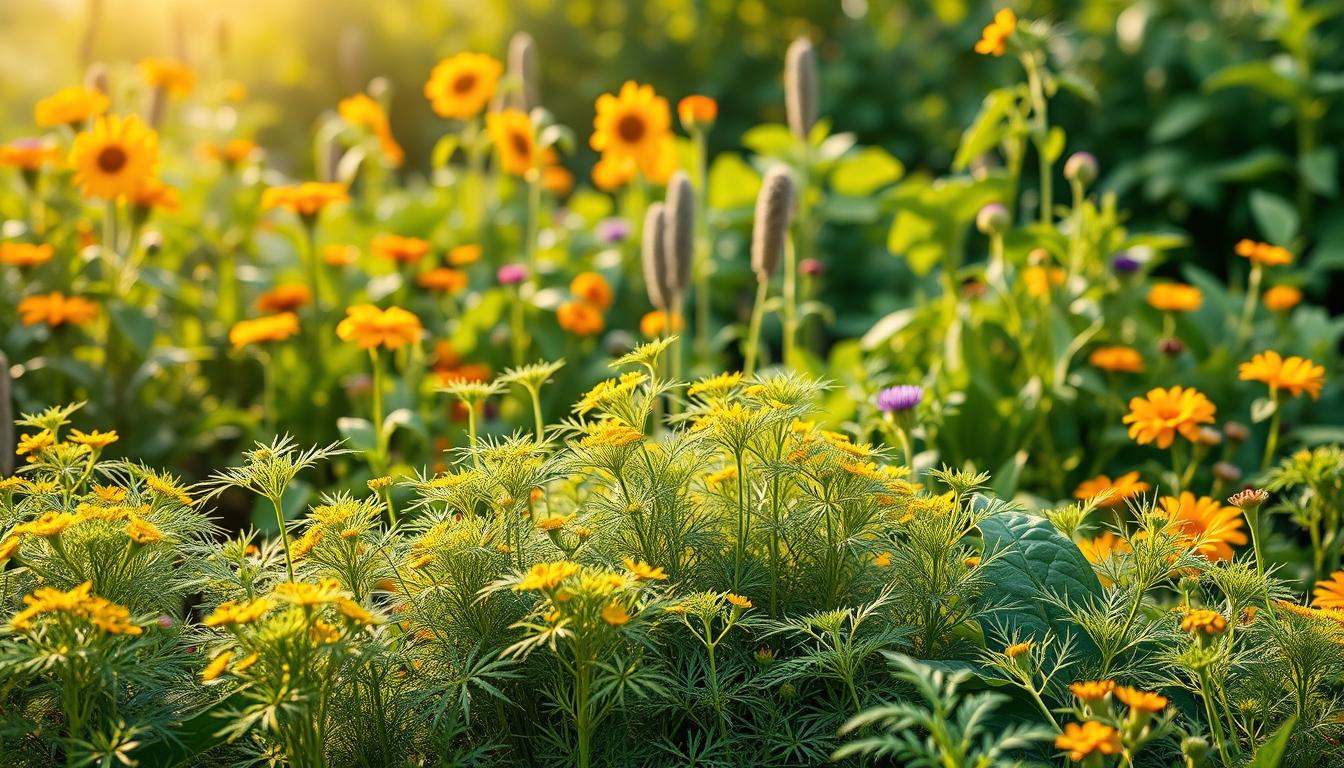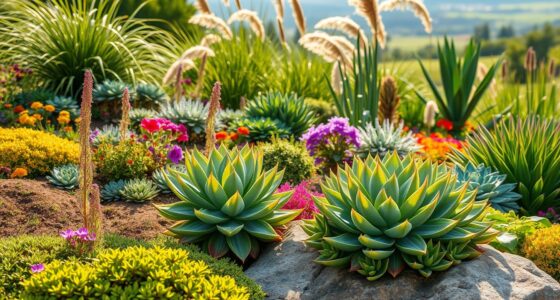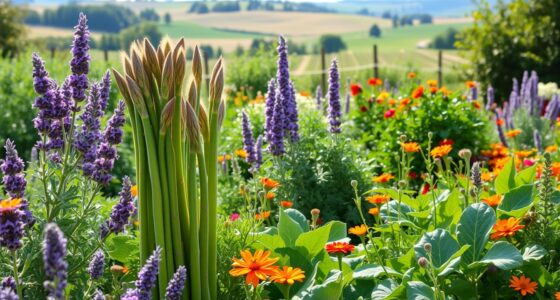Have you ever watched your plants flourish in the spring sunshine, their vibrant greens reaching for the sky and a sense of accomplishment washing over you? Gardening is not just about growing food; it’s also about cultivating a deeper connection with nature and mastering the art of companion planting. In this exciting journey, dill emerges as a versatile hero in your garden—a fragrant herb that can elevate both the health and flavor of your plants. But finding the best companion plants for dill can feel overwhelming. Fear not, as this comprehensive companion planting guide for dill will illuminate the best allies for your beloved herb, helping you create a thriving garden ecosystem.
Key Takeaways
- Dill is a versatile herb that can enhance growth and health in your garden.
- Choosing the best companion plants for dill maximizes space and resources.
- Dill attracts beneficial insects while deterring harmful pests.
- Understanding companion planting helps create a balanced garden ecosystem.
- This guide provides insights into compatible plants that thrive alongside dill.
Why Dill Companion Planting Matters
Understanding the importance of dill companion planting can elevate your gardening success. Companion planting involves pairing plants that benefit each other, creating a thriving ecosystem in your garden. When you incorporate dill garden companions, you can optimize growth, increase flavors, and create a healthier environment for your plants.
Enhancing Growth and Flavor
Using a companion planting guide for dill reveals how its aromatic properties can positively affect neighboring plants. Dill attracts pollinators, which can lead to improved fruit and seed production. Plants grown near dill often achieve better nutrient absorption, resulting in enhanced flavor and yield. This makes choosing the right dill companion plants crucial for maximizing your harvest.
Natural Pest Control
One of the significant benefits of planting dill with others is its natural pest-repelling qualities. Dill attracts beneficial insects like ladybugs and parasitic wasps that feed on common garden pests. By reducing reliance on chemical pesticides, your garden becomes a healthier space for all its inhabitants. Incorporating dill garden companions helps create a balanced environment, effectively controlling unwanted pests while promoting healthy growth.

Best Companion Plants for Dill
Finding the best companion plants for dill can enhance your gardening experience, leading to healthier plants and better yields. Certain plants flourish when paired with dill, thanks to their ability to attract beneficial insects or repel harmful pests. In this section, we will explore some of the top choices for planting with dill.
Cabbage Family Members
Members of the cabbage family, such as broccoli and kale, are excellent partners for dill. The dill plant compatibility with these vegetables arises from its natural pest-repelling qualities. By planting cabbage family members with dill, you can help protect them from common pests that would otherwise threaten their growth.
Cucumbers and Squash
Cucumbers and squash not only benefit from dill’s companion planting advantages but also attract beneficial insects that guard these vegetables against cucumber beetles. The companionship fosters an environment where both plants can thrive, leading to a more productive garden.
Carrots and Onions
When planting with dill, it’s worth noting that it can be paired successfully with onions, which deter carrot root flies. This combination can lead to healthier carrot crops. However, avoid planting dill too close to carrots, as their potential for cross-pollination may stymie growth and affect flavor.

Herbs That Thrive with Dill
Dill is not only a beautiful herb to grow, but it also makes an excellent companion for several other herbs. When considering the herbs that grow well with dill, you’ll find that some really complement each other in terms of flavor and overall garden health. Here’s a look at a few standout options that you should consider adding to your dill companion plants list.
Basil: A Perfect Pair
Basil thrives in moist, nutrient-rich soil, much like dill. Their similar requirements create an ideal growing environment that allows both herbs to flourish. Furthermore, basil’s aromatic oils can help deter pests, providing additional protection for dill.
Thyme: Flavor Enhancer
Integrating thyme alongside dill enriches your garden’s flavor profile. Both herbs enjoy sunny spots, making them perfect partners in the garden. Thyme can enhance the overall health of dill, promoting better growth and resilience against diseases.
Cilantro and Dill: Friends in the Kitchen
Cilantro aligns well with dill due to their overlapping growing conditions. These two herbs can attract beneficial insects that help improve the health of your garden. Their combined fragrances creates a delightful experience in your culinary preparations, making them perfect companions not just in the garden, but also in your kitchen.
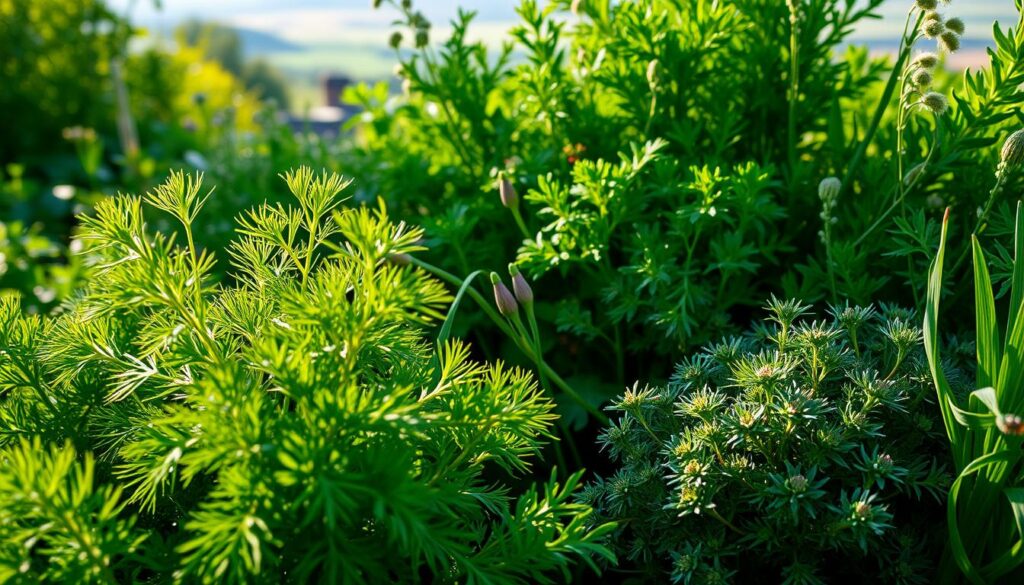
Vegetables That Prosper Alongside Dill
Creating a vibrant garden ecosystem relies on choosing the right dill garden companions. Certain vegetables that grow well with dill benefit immensely from its presence. Understanding these relationships can enhance the growth and flavor of your produce, making your gardening efforts more rewarding.
Peppers: A Spicy Match
Peppers thrive alongside dill, enjoying similar growing conditions. The presence of dill encourages healthier pepper plants by attracting beneficial insects that help with pollination and natural pest control. Pairing these two plants allows for an abundant harvest of both spicy and fragrant flavors.
Tomatoes: A Harmonious Duo
Tomatoes can find a supportive partner in dill during their early growth stages. Young dill provides a protective barrier against certain pests, fostering a conducive environment for tomato development. Caution is advisable as mature dill may compete for nutrients and potentially inhibit tomato growth. Careful planning ensures both vegetables achieve their full potential in your garden.

Flowers That Benefit Dill
Integrating flowers that grow with dill in your garden can create a thriving ecosystem while enhancing the overall beauty of your space. Certain flowers, such as marigolds and nasturtiums, not only complement dill but also offer benefits in pest control and pollination. These floral companions serve as powerful allies in your gardening journey.
Marigolds: Pest Deterrent
Marigolds are renowned for their ability to deter pests, particularly aphids and nematodes. When you plant marigolds alongside dill, you create a natural barrier against these unwanted insects. Furthermore, their bright yellow and orange blooms attract beneficial pollinators, which can enhance the flowering of your dill plants. Following dill companion planting tips, combining these two can result in a healthier and more productive garden.
Nasturtiums: Companion Flower Power
Nasturtiums are another valuable addition to your garden when growing dill. These vibrant flowers attract a variety of pollinators, ensuring that not only your dill but also other nearby plants benefit from increased pollination. In addition to this, nasturtiums can help deter pests while also serving as a trap crop. In this way, they lure harmful insects away from your dill, thereby safeguarding its growth. Utilizing flowers that grow with dill like nasturtiums amplifies the effectiveness of your companion planting strategy.

Plants to Avoid with Dill
Understanding dill plant compatibility plays a crucial role in your gardening success. Some plants simply do not fare well alongside dill, posing risks to both growth and flavor. Identifying these plants to avoid with dill can help you maintain a harmonious garden environment.
Fennel: A Competitive Neighbor
Fennel stands out as one of the most significant competitors to dill. Both plants share similar nutrient needs and can easily overshadow one another. Planting these two together often leads to reduced growth for both. Gardeners typically experience challenges when attempting to cultivate fennel near dill, as they may find their crops competing rather than flourishing.
Other Herbs: Potential Conflicts
Several other herbs can create conflicts when planted too close to dill. Certain strong herbs may inhibit dill’s growth or alter its flavor. Noteworthy names in this category include:
- Caraway
- Parsley
- Celery
These herbs are related to dill and thus share similar growing conditions. Keeping these plants away from dill helps ensure they do not compete for valuable resources, maintaining a thriving garden.

Optimal Growing Conditions for Dill
To achieve the best results when growing dill successfully, it’s essential to understand its environmental requirements. Providing optimal conditions for dill will enable this aromatic herb to flourish in your garden. The key aspects to consider include sunlight and soil preferences.
Sunlight Requirements
Dill thrives in full sun, so be sure to plant it in a location that receives at least six hours of sunlight daily. The more sunlight your dill gets, the healthier and more flavorful it will become. Insufficient sunlight can lead to leggy growth and reduced flavor, which can hinder your overall gardening success.
Soil Preferences
Another vital factor in growing dill successfully is the type of soil you choose. Dill prefers well-draining, moist soil that maintains a balanced level of nutrients. The ideal choice includes nutrient-rich loamy soil with excellent drainage properties. Using compost can enhance the soil quality and provide a perfect environment for your dill, allowing it to thrive and grow alongside its companion plants without competing for resources.
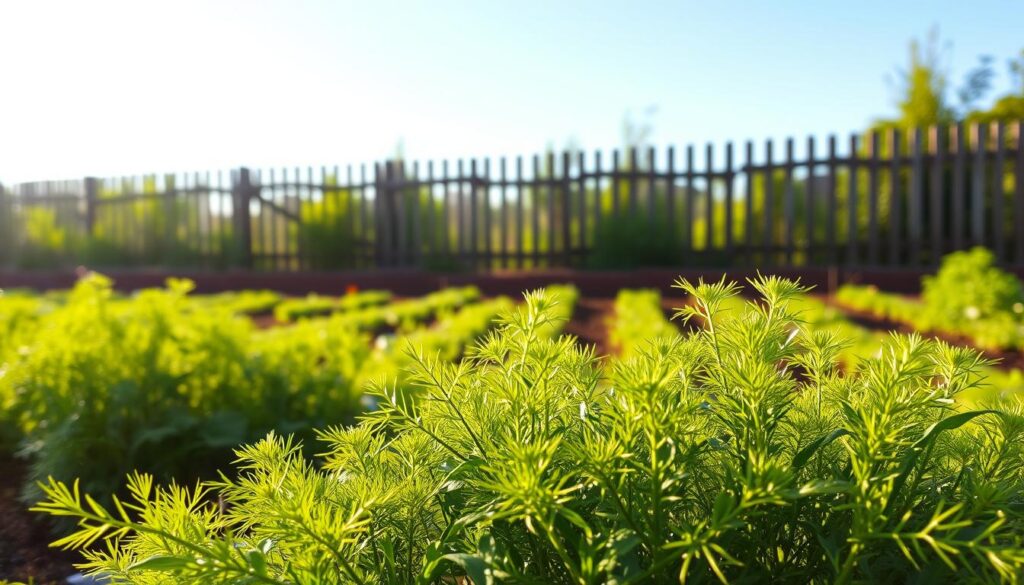
Timing Your Planting Schedule
Timing plays a critical role in planting with dill. When you plan your dill companion planting schedule, consider the best companions for various growing seasons. Early planting can yield a harmonious garden filled with nutritious options, while late-season planting allows you to capitalize on the benefits of herbs that will flourish alongside your dill.
Ideal Companions for Early Dill
In the early growing season, dill pairs well with cabbage and lettuce. These plants thrive in cool weather and can help to create a balanced garden ecosystem. When planting with dill during this time, you’ll enhance growth and can enjoy a bountiful yield. The pairing with cabbage takes advantage of similar growing conditions, leading to a successful early harvest.
Late-Season Planting Options
As the season progresses, consider herbs such as basil or cilantro that can enrich your garden alongside mature dill. These late-season companions provide an ideal mix and continue to yield flavor as the weather cools. Adapting your dill companion planting schedule to incorporate these herbs promotes a diverse and productive garden space.

Maintenance Tips for Successful Dill Growth
To ensure healthy and thriving dill plants, proper maintenance is crucial. Taking the right steps in watering and fertilizing will benefit both dill and its companion plants. Here are some essential tips for effective care.
Watering Strategies
Consistent watering plays a vital role in the health of your dill plants. You should aim to keep the soil moist but not soggy. Check the top inch of soil; if it feels dry, it’s time to water. For optimal dill companion plants care, consider the following:
- Water early in the morning or late in the afternoon to minimize evaporation.
- Apply water directly to the base of the plants to avoid wetting the leaves, which can lead to disease.
- Use mulch to help retain soil moisture and regulate temperature.
Fertilizing Dill and Companions
Maintaining dill and companion plants involves proper feeding to encourage growth. Select fertilizers based on your soil’s needs. Here are some tips for effective fertilization:
- Use a balanced organic fertilizer or compost for initial planting.
- Reapply every four to six weeks during the growing season.
- Test your soil periodically to adjust nutrient levels accordingly.

Harvesting and Using Dill
Harvesting dill at the right moment enhances its flavor and culinary potential. As you begin the process of harvesting dill, remember that timing plays a crucial role. This herb thrives when its leaves are vibrant and lush, indicating peak flavor. Follow these expert techniques to make the most out of your dill harvest.
Best Techniques for Harvesting
To achieve the most aromatic and flavorful dill, consider the following harvesting techniques:
- Cut stems above the base to promote regrowth, ensuring you can enjoy multiple harvests.
- Harvest early in the morning when essential oils are most concentrated.
- Use sharp scissors or garden shears for clean cuts, minimizing damage to the plant.
Culinary Uses for Dill
Dill adds a unique flavor to countless dishes, making it a beloved herb in homes. Its culinary uses are vast and versatile:
- Pickling: Dill is a staple ingredient in pickles, lending a fresh taste to cucumbers and other vegetables.
- Salads: Adding fresh dill to salads elevates the flavor, making your greens more vibrant.
- Seasoning: Incorporate dill into fish dishes, yogurt sauces, or creamy dips to enhance their taste.

Seasonal Considerations for Dill Companions
Understanding the seasonal needs of dill and its companion plants is key to a thriving garden. During spring, dill seasonal planting aligns perfectly with cooler-season crops, allowing for an optimal growing environment. As the temperatures rise, the strategy may shift, necessitating careful consideration in adjusting companions for summer growing conditions.
Spring Planting Tips
For successful spring planting, consider choosing companions that enjoy the same climatic conditions as dill. Crops such as cabbage and peas easily fit into this category. Their growth patterns complement dill’s, creating a harmonious planting atmosphere. Make sure to prepare your soil adequately, enriching it with organic matter to promote healthy growth.
Summer Companion Adjustments
As summer approaches, planning becomes crucial. Heat-loving plants thrive best in warm temperatures, so adjusting companions for summer is essential. Opting for tomatoes or peppers alongside dill can maximize your garden’s productivity. Remember to monitor spacing carefully, allowing ample room for each plant to flourish without overcrowding.
| Season | Ideal Companions | Key Considerations |
|---|---|---|
| Spring | Cabbage, Peas | Cooler temperatures, proper soil enrichment |
| Summer | Tomatoes, Peppers | Warm temperatures, adequate spacing |
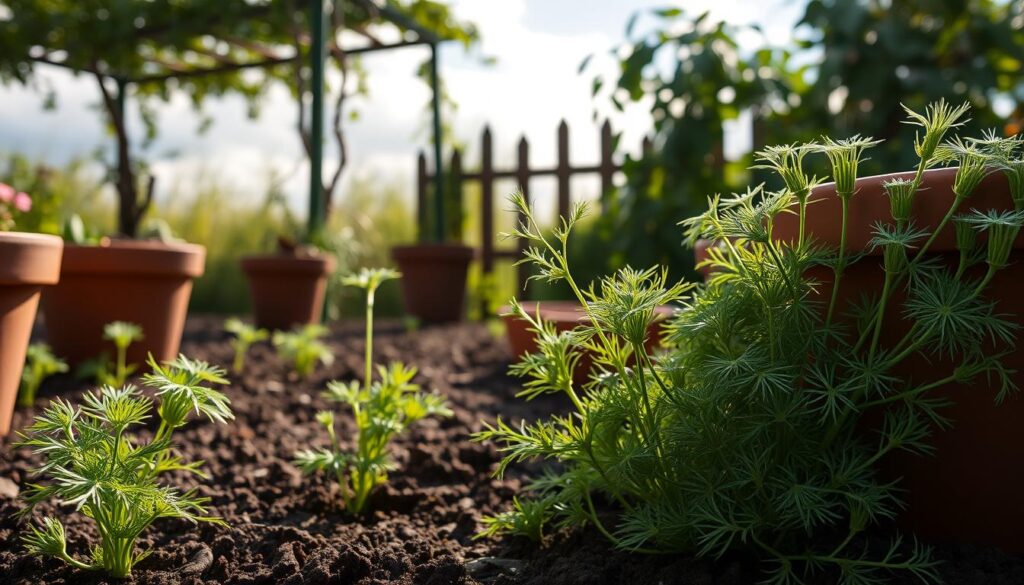
Common Mistakes in Dill Companion Planting
Engaging in dill companion planting can significantly enhance your garden, but certain pitfalls can lead to disappointing results. Understanding and addressing common dill companion planting mistakes ensures your dill and its companions flourish. Two major issues include overcrowding and neglecting specific plant needs. By optimizing space for dill and considering the requirements of its companion plants, you can maximize the potential benefits of this gardening practice.
Overcrowding: Giving Plants Space
One of the most frequent dill companion planting mistakes involves overcrowding. Plants require adequate space to grow without competition for nutrients, light, and water. When dill is planted too close to its companions, both the dill and other plants may suffer from stunted growth and decreased yields. To avoid this, create a well-planned layout that allows for optimal spacing. This approach can significantly enhance the overall health of your garden.
Ignoring Plant Needs: A Recipe for Failure
Another common oversight is ignoring the specific needs of each plant involved in companion planting. Each plant has unique requirements regarding sunlight, water, and soil type. Failure to address these needs can result in poor plant performance. By understanding each plant’s preferences and conditions, you can effectively tailor your approach, thereby optimizing space for dill and creating a thriving garden ecosystem.
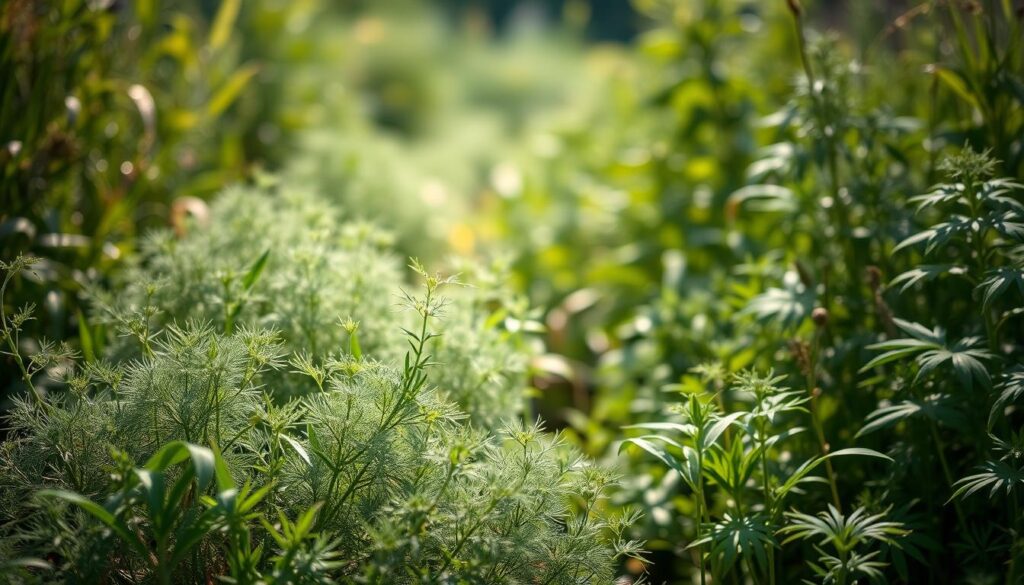
Resources for Further Reading on Companion Planting
If you’re eager to enhance your garden with dill and its companions, a wealth of resources awaits you. Engaging with various materials can provide you with the necessary knowledge and inspiration to master companion planting effectively. From books to online communities, you have plenty of opportunities to expand your expertise.
Gardening Books and Guides
Dive into specialized gardening books on companion planting that focus specifically on herbs and vegetables. Notable titles include “Carrots Love Tomatoes” and “Companion Planting for Beginners,” which provide comprehensive information on the best pairing strategies. These resources for dill companion planting are essential for both novice and seasoned gardeners looking to optimize their gardening practices.
Online Communities and Forums
Joining online gardening communities or forums can be a fantastic way to interact with fellow gardening enthusiasts. Platforms such as Reddit’s r/gardening or specialized Facebook groups allow you to share experiences, ask questions, and find valuable tips. Leveraging these online resources can greatly enhance your understanding of companion planting and help you cultivate a thriving environment for your dill and accompanying plants.
